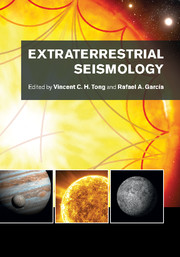Book contents
- Frontmatter
- Contents
- List of contributors
- Preface
- Acknowledgements
- List of abbreviations
- Planetary seismology: High risk, high return
- A bright outlook for helio- and asteroseismology
- Part I Observation and space missions
- 1 Asteroseismology observations and space missions
- 2 Helioseismology: Observations and space missions
- 3 Planetary seismometry
- Part II Data and physical parameters
- Part III Modeling approaches
- Part IV Discoveries of physical structures and processes
- Part V Interdisciplinary research involving planetary and astrophysical sciences
- Part VI Interdisciplinary research involving terrestrial seismology
- References
- Index
2 - Helioseismology: Observations and space missions
from Part I - Observation and space missions
Published online by Cambridge University Press: 05 July 2015
- Frontmatter
- Contents
- List of contributors
- Preface
- Acknowledgements
- List of abbreviations
- Planetary seismology: High risk, high return
- A bright outlook for helio- and asteroseismology
- Part I Observation and space missions
- 1 Asteroseismology observations and space missions
- 2 Helioseismology: Observations and space missions
- 3 Planetary seismometry
- Part II Data and physical parameters
- Part III Modeling approaches
- Part IV Discoveries of physical structures and processes
- Part V Interdisciplinary research involving planetary and astrophysical sciences
- Part VI Interdisciplinary research involving terrestrial seismology
- References
- Index
Summary
Introduction
The great success of helioseismology resides in the reearkable progress achieved in the understanding of the structure and dynamics of the solar interior. This success mainly relies on the ability to conceive, implement, and operate specific instrumentation with enough sensitivaty to detect and measure small fluctuations (in velocity and/or intensity) on the solar surface that are well below one meter per second or a few parts per million. Furthermore, the limitation of ground observations imposed by the day–night cycle (thus a periodic discontinuity in the observations) was overcome with the deployment of ground-based networks – properly placed at different longitudes all over the Earth – allowing longer and continuous observations of the Sun and consequently increasing their duty cycle.
In this chapter, we start with a short historical overview of helioseismology. Then we describe the different techniques used for helioseismic analyses along with a description of the main instrumental concepts. We particularly focus on the instruments that have been operating long enough to study the solar magnetic activity. Finally, we highlight the main results obtained with such high-duty cycle observations (>80%) over the past few decades.
A historical overview
The detection of solar oscillations goes back to more than 50 years ago when Leighton et al. (1962) discovered the five-minute oscillations in the solar photosphere. However, it was only with the observations of Deubner (1975) that their identity as standing acoustic waves, i.e., normal modes of the Sun of high spherical-harmonic degree, was established, confirming previous theoretical inferences by Ulrich (1970) and Leibacher and Stein (1971), thus setting the scene for the development of helioseismology. Coincidentally, a strong inspiration was the announcement in 1975 by the SCLERA (Santa Catalina Laboratory for Experimental Relativity by Astrometry) group of evidence for oscillations in the solar diameter (see Hill et al., 1976), of apparently truly global nature and hence containing information about the entire Sun.
- Type
- Chapter
- Information
- Extraterrestrial Seismology , pp. 25 - 35Publisher: Cambridge University PressPrint publication year: 2015

